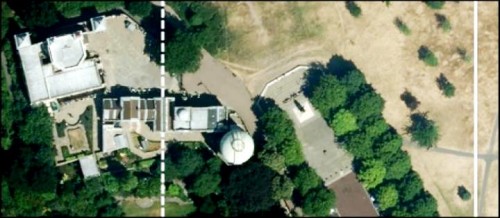
Walk the line: Airy meridian is marked as the “Prime Meridian of the World” (dotted line), and the modern reference meridian indicating zero longitude using GPS (solid line).
(Courtesy: 2014 Google Maps, Infoterra & Bluesky)
By Tushna Commissariat
A visit to the Royal Observatory in Greenwich is incomplete without walking along the Prime Meridian of the world – the line that literally divides the east from the west – and taking some silly photos across it. But you may be disappointed to know that the actual 0° longitudinal line is nearly 100 m away, towards the east, from the plotted meridian. Indeed, your GPS would readily show you that the line actually cuts through the large park ahead of the observatory. I, for one, am impressed that the original line is off by only 100 m, considering that it was plotted in 1884. A recently published paper in the Journal of Geodesy points out that with the extreme accuracy of modern technology like GPS, which has replaced the traditional telescopic observations used to measure the Earth’s rotation, we can measure this difference. You can read more about it in this article in the Independent.
On Monday this week, we ran a story on how scientists have recalibrated the entire 400-year-long data of sunspot activity, to get a much better idea of solar activity and its impact on our climate. Today, I spotted this neat little story that seems to link that sunspot activity and a once-stolen (and now returned) Stradivarius violin that originally belonged to Polish-American violinist Roman Totenberg. NPR in the US ran a story about how Totenberg’s violin, stolen 35 years ago, has just been returned to his family. The Washington Post, though, looked a bit more into the history of Stradivarius violins. No-one is quite sure just yet why their tone and sound quality is superior and theories still abound. The Post article suggests that it may have been a direct result of the Maunder minimum and the “Little Ice Age” that occurred when Antonio Stradivari was making his instruments. Scientists believe that he lucked out with the distinctive quality of the spruce and maple trees that grew in the forests of Northern Europe at that time. I’m not sure if we will ever know exactly what went into making his violins sound so wonderful, but it seems like we may have the Sun to thank for it.
We also spotted this fun post, by physicist Robert Scherrer on his blog Cosmic Yarns, where he delves into the funny and whimsical names that physicists tend to give their experiments. He mentions the fact that fictional scientists often have very serious-sounding and plausible experiment names, while their real-life counterparts take the sillier route. Indeed, those of you who read Physics World magazine may remember the Lateral Thoughts column from March this year was in the same vein, with physicist Rick Trebino writing “Acronyms Anonymous” about physics experiments he has known – and named. Scherrer has listed a few of the more amusing and downright silly names of current experiments – PINGU and DORIS are my favourites – on his blog, but let us know if any are missing. “So are those of us who do physics and astronomy just intrinsically funnier than our colleagues in biology and chemistry? Yes. Yes, we are,” writes Scherrer.
For some weekend viewing, those of you in the UK can watch this week’s episode of Coast on BBC 2 where comedian and physicist Helen Arney explores a dark-matter cave — also known as the Boulby Underground Laboratory. Of course, Physics World’s editor Matin Durrani went there first!
Guidelines
Show/hide formatting guidelines
this text was deletedwhere people live in harmony with nature and animals</q>
Some text